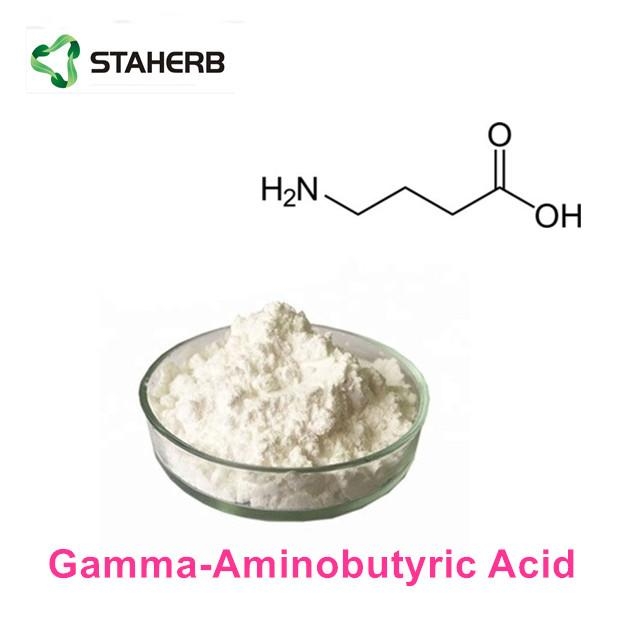
γ-aminobutyric acid
Product Name:GABA aminobutyric acid
Apperance:White powder
Specification:99%
Active Ingredient:GABA
CAS NO.:56-12-2
Molecular formula:C4H9NO2
Application:food additive

Aminobutyric acid/GABA is a non-protein amino acid that functions as a neurotransmitter (a chemical that facilitates communication between neurons). Neurotransmitters are either "excitatory" (i.e. they stimulate the firing of a neuron) or "inhibitory" (i.e., they tend to suppress neuron firing). GABA, which is produced from glutamate, is an inhibitory neurotransmitter. In fact, it's the primary inhibitory neurotransmitter in the brain.
Aminobutyric acid main Function:
1.Beta Aminobutyric Acid is major neurotransmitter widely distributed throughout the central nervous system (CNS).
2.This neurotransmitter appears to have a significant influence on the pituitary gland’s hormone secretion, primarily through its hypothalamic effect.
3.Beta Aminobutyric Acid is also the most important and widespread inhibitory neurotransmitter in the brain.
4.It helps prevent the over-firing of the nerve cells and decreases overall neuron activities in the CNS. Over-firing can cause restlessness, spasmodic movements, irritability and anxiety.
5. Beta Aminobutyric Acid is also utilized by the brain to create tranquility and calmness through the brain’s metabolic processes.
Aminobutyric acid Application:
1.as raw materials for the medicines, health products and cosmetics.
2.directly adding into the tea, beverages and milk products.
3.as the natural ingredients used in coffee, chocolate, apple juice, cocoa, yogurt, milk sugar, butter, toast, bread, instant noodles and other functional food and drinks.
For more product information pls contact at email sales09@staherb.cn

- References:
- 1.
É. A. Bendikov and V. G. Butuzov, in: The Pharmacology of Monoaminergic Processes [in Russian], Moscow (1971), p. 24.
- 2.
É. A. Bendikov and V. G. Butuzov, in: The Pharmacology of Monoaminergic Processes [in Russian], Moscow (1971), p. 42.
- 3.
É. A. Bendikov and V. G. Butuzov, in: The Pharmacology of Monoaminergic Processes [in Russian], Moscow (1971), p. 53.
- 4.
V. G. Butuzov and É. A. Bendikov, Farmakol. i Toksikol., No. 5, 535 (1969).
- 5.
N. A. Esayan, A. R. Armenyan, and L. N. Arakelyan, in: Problems in Biochemistry of the Brain [in Russian], part 3, Erevan (1967), p. 313.
- 6.
V. V. Zakusov, Vestn. Akad. Med. Nauk SSSR, No. 4, 43 (1964).
- 7.
V. V. Zakusov (editor), Sodium Hydroxybutyrate [in Russian], Moscow (1968).
- 8.
N. V. Kaverina and Yu. B. Rozonov, Byull. Éksperim. Biol. i Med., No. 2, 60 (1966).
- 9.
N. A. Kruglov and R. I. Kvasnoi, in: Sodium Hydroxybutyrate [in Russian], Moscow (1968), p. 48.
- 10.
S. A. Mirzoyan, B. A. Kazaryan, and V. P. Akopyan, in: Current Problems in Pharmacology [in Russian], Kiev (1971), p. 184.
- 11.
S. A. Mirzoyan and R. G. Boroyan, in: Problems in Biochemistry of the Brain [in Russian], part 3, Erevan (1967), p. 117.
- 12.
R. U. Ostrovskaya, N. M. Tsybina, T. V. Protopopova, et al., Khim.-Farmets. Zh., No. 12, 21 (1969).
- 13.
R. A. Khaunina and M. N. Maslova, in: Problems in Psychiatry and Neuropathology [in Russian], No. 13, Leningrad (1968), p. 583.
- 14.
J. C. Eccles, The Physiology of Synapses, Springer, Berlin (1964).
- 15.
D. P. Becker, H. F. Young, F. E. Nielsen, et al., Exp. Neurol.,24, 272 (1969).
- 16.
D. R. Curtis, A. W. Duggon, and D. Felix, Brain Res.,23, 117 (1970).
- 17.
D. R. Curtis, D. Felix and H. McLenna, Brit. J. Pharmacol.,40, 881 (1970).
- 18.
A. Halpern and G. Neck, United States Patent No. 3172, 8.12 (1965).
- 19.
T. Hayashi, Hospital (Rio),75, 109 (1969).
- 20.
H. Laborit, Internat. J. Neuropharmacol.,3, 433 (1964).